Metabolic Rate Measuring with Indirect Calorimetry for Thermal Comfort Evaluation
Abstract
:1. Introduction
2. Methodologies
2.1. Subjects
2.2. Environmental Parameter Measurements
2.3. Physiological Measurements
2.4. Subjective Questionnaire
2.5. Experimental Procedure
2.6. Statistical Analysis
3. Results and Discussion
3.1. The Variation of Physiological Parameters over Time
3.2. Comparisons of Physiological Parameters in Various Environments
3.3. Predictive Equations for MET Based on Walking Speed
3.4. Predictive Equations for MET Based on HR
3.5. The Comparisons of TSV and PMV
3.6. Limitation and Future Works
4. Conclusions
- (1)
- The environments have little impact on MET, except the MET of 6 km/h walking in the hot environment, which is about 10 W/m2 higher than that in the cold and warm environments (p = 0.006 and p < 0.01). On the contrary, the HR of all activities in the cool environment is significantly lower at 3–7 bpm than that in the other environments (p < 0.05).
- (2)
- The linear, exponential, and quadratic polynomial relationships between walking speed and MET are fitted. Compared to most research, there are higher intercepts and lower slopes of linear predictive equations in this study. That means that the values of MET at low activity are higher than others, and the values of MET at high activity are lower in this study. In addition, the linear relationship can better represent the relevance between MET and walking speed than the exponential and quadratic polynomial relationships.
- (3)
- The linear relationships between HR and MET at the cool and the other environments are fitted, respectively: MET = 3.67 × HR − 195.56 and MET = 3.80 × HR − 218.90. The slope and intercept of the latter are higher than the former, although the R2 of them is equivalent (0.77 and 0.76). It indicates that the RM in the cool environment is lower than the others.
- (4)
- The TSV and PMV from various sources of MET at sitting and 2 km/h and 4 km/h walking are collected and compared. The TSV always rises following the increase in activity intensity, and the environment becomes warm. For the sitting activity, a slight difference from the MET could cause a significant difference in PMV, which leads to a PMV that may be above, below, or close to the TSV. For the 2 km/h walking activity, five kinds of PMV are close to TSV. On the contrary, for the 4 km/h walking activity, the PMV is always higher than the TSV.
Author Contributions
Funding
Institutional Review Board Statement
Informed Consent Statement
Data Availability Statement
Conflicts of Interest
References
- ANSI/ASHRAE Standard 55-2020; Thermal Environmental Conditions for Human Occupancy. American Society of Heating, Refrigerating and AirConditioning Engineers: Atlanta, GA, USA, 2020.
- Fanger, P.O. Assessment of man’s thermal comfort in practice. Br. J. Ind. Med. 1973, 30, 313–324. [Google Scholar] [CrossRef] [PubMed]
- ISO 7730; Ergonomics of the Thermal Environment—Analytical Determination and Interpretation of Thermal Comfort Using Calculation of the PMV and PPD Indices and Local Thermal Comfort Criteria. International Organization for Standardization: Geneva, Switzerland, 2010.
- d’Ambrosio Alfano, F.R.; Ianniello, E.; Palella, B.I. PMV-PPD and acceptability in naturally ventilated schools. Build. Environ. 2013, 67, 129–137. [Google Scholar] [CrossRef]
- Manu, S.; Shukla, Y.; Rawal, R.; Thomas, L.E.; de Dear, R. Field studies of thermal comfort across multiple climate zones for the subcontinent: India Model for Adaptive Comfort (IMAC). Build. Environ. 2016, 98, 55–70. [Google Scholar] [CrossRef]
- Ning, H.; Wang, Z.; Zhang, X.; Ji, Y. Adaptive thermal comfort in university dormitories in the severe cold area of China. Build. Environ. 2016, 99, 161–169. [Google Scholar] [CrossRef]
- ISO 8996; Ergonomics of the Thermal Environment—Determination of Metabolic Rate. International Organization for Standardization: Geneva, Switzerland, 2004.
- ASHRAE. ASHRAE Handbook Fundamentals; American Society of Heating, Refrigerating and AirConditioning Engineers: Atlanta, GA, USA, 2021. [Google Scholar]
- Liu, J.; Foged, I.W.; Moeslund, T.B. Automatic estimation of clothing insulation rate and metabolic rate for dynamic thermal comfort assessment. Pattern Anal. Appl. 2022, 25, 619–634. [Google Scholar] [CrossRef]
- Wang, K.; Wang, Y.; Xue, S. Study on the Thermal Comfort of People with Different Activity Intensities in the Urban Park During Winter in Cold Regions of China. Build. Sci. 2023, 39, 97–103. [Google Scholar]
- Lin, Y.; Jin, H.; Jin, Y.; Kang, J. Experimental study on the effects of exercise intensity and thermal environment on thermal responses. Build. Environ. 2023, 232, 110067. [Google Scholar] [CrossRef]
- Choi, J.-H.; Loftness, V.; Lee, D.-W. Investigation of the possibility of the use of heart rate as a human factor for thermal sensation models. Build. Environ. 2012, 50, 165–175. [Google Scholar] [CrossRef]
- Luo, M.; Wang, Z.; Ke, K.; Cao, B.; Zhai, Y.; Zhou, X. Human metabolic rate and thermal comfort in buildings: The problem and challenge. Build. Environ. 2018, 131, 44–52. [Google Scholar] [CrossRef]
- Nomoto, A.; Hisayama, R.; Yoda, S.; Akimoto, M.; Ogata, M.; Tsutsumi, H.; Tanabe, S.-i. Indirect calorimetry of metabolic rate in college-age Japanese subjects during various office activities. Build. Environ. 2021, 199, 107909. [Google Scholar] [CrossRef]
- Anand, V.; Sendhil, D.; Rajasekar, E. Estimating the metabolic rate and associated physiological response for Indian subjects through climate chamber experiments. Build. Environ. 2022, 207, 108466. [Google Scholar] [CrossRef]
- Zhai, Y.; Elsworth, C.; Arens, E.; Zhang, H.; Zhang, Y.; Zhao, L. Using air movement for comfort during moderate exercise. Build. Environ. 2015, 94, 344–352. [Google Scholar] [CrossRef]
- Zhai, Y.; Zhao, S.; Gao, Y.; Song, W.; Yang, L.; Zhang, H.; Arens, E. Preferred temperatures with and without air movement during moderate exercise. Energy Build. 2020, 207, 109565. [Google Scholar] [CrossRef]
- Jia, X.; Wang, J.; Zhu, Y.; Ji, W.; Cao, B. Climate chamber study on thermal comfort of walking passengers at different moving speeds. Build. Environ. 2022, 224, 109540. [Google Scholar] [CrossRef]
- Liu, X.; Liu, S.; Zhang, H.; Ye, T.; Na, Y.; Zheng, W. An investigation of college students on metabolic rate considering activity intensity, ambient temperature and clothing insulation. Build. Environ. 2023, 245, 110865. [Google Scholar] [CrossRef]
- Zhai, Y.; Li, M.; Gao, S.; Yang, L.; Zhang, H.; Arens, E.; Gao, Y. Indirect calorimetry on the metabolic rate of sitting, standing and walking office activities. Build. Environ. 2018, 145, 77–84. [Google Scholar] [CrossRef]
- Bois, D.; Bois, E. A height-weight formula to estimate the surface area of man. Proc. Soc. Exp. Biol. Med. 1916, 13, 77–78. [Google Scholar] [CrossRef]
- Nishi, Y. Measurement of Thermal Balance of Man. In Studies in Environmental Science; Cena, K., Clark, J.A., Eds.; Elsevier: Amsterdam, The Netherlands, 1981; pp. 29–39. [Google Scholar]
- Liu, W.; Deng, Q.; Ma, W.; Hao, H.; Zhao, J. Feedback from human adaptive behavior to neutral temperature in naturally ventilated buildings: Physical and psychological paths. Build. Environ. 2013, 67, 240–249. [Google Scholar] [CrossRef]
- Buskirk, E.R. Problems related to the caloric cost of living. Bull. N. Y. Acad. Med. 1960, 36, 365–388. [Google Scholar] [PubMed]
- Liu, G.; Qi, F.; Hu, S.; Li, A.; Wang, H.; Wang, M.; Tong, L. Experiment and Thermal Sensation Estimating Model at Different Active Levels Under Hypobaric Condition Based on Principal Component Analysis. In Proceedings of the 8th International Symposium on Heating, Ventilation and Air Conditioning, Volume 1: Indoor and Outdoor Environment, Xi’an, China, 19–21 October 2013; Springer: Berlin/Heidelberg, Germany, 2014; pp. 289–296. [Google Scholar] [CrossRef]
- Cui, W.; Wang, H.; Wu, T.; Ouyang, Q.; Hu, S.; Zhu, Y. The influence of a low air pressure environment on human metabolic rate during short-term (<2 h) exposures. Indoor Air 2017, 27, 282–290. [Google Scholar] [CrossRef]
- Kingma, B.; Lichtenbelt, W.v.M. Energy consumption in buildings and female thermal demand. Nat. Clim. Change 2015, 5, 1054–1056. [Google Scholar] [CrossRef]
- Lazzer, S.; Bedogni, G.; Lafortuna, C.L.; Marazzi, N.; Busti, C.; Galli, R.; De Col, A.; Agosti, F.; Sartorio, A. Relationship Between Basal Metabolic Rate, Gender, Age, and Body Composition in 8780 White Obese Subjects. Obesity 2010, 18, 71–78. [Google Scholar] [CrossRef]
- Hall, C.; Figueroa, A.; Fernhall, B.; Kanaley, J.A. Energy expenditure of walking and running: Comparison with prediction equations. Med. Sci. Sports Exerc. 2004, 36, 2128–2134. [Google Scholar] [CrossRef]
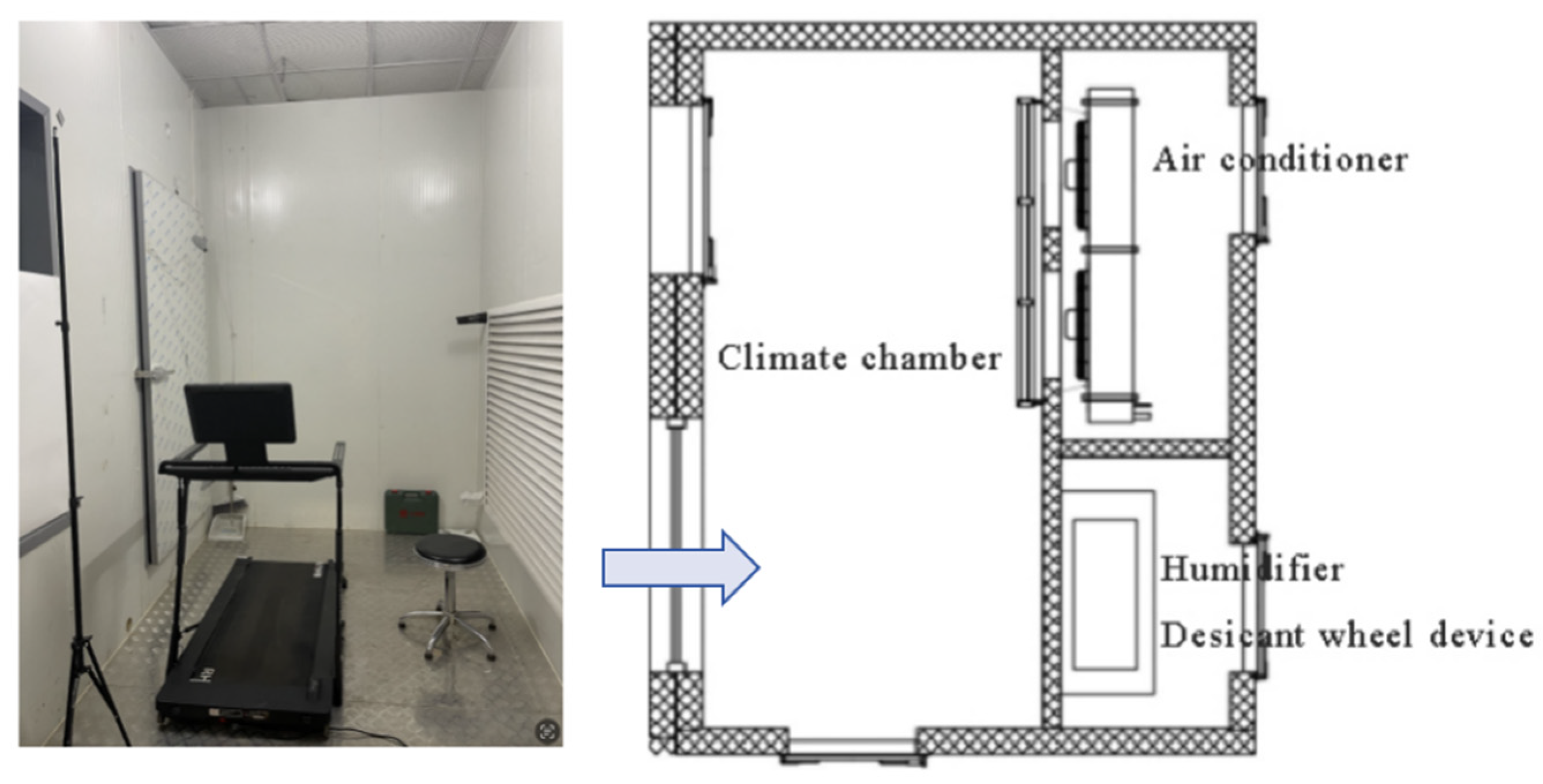




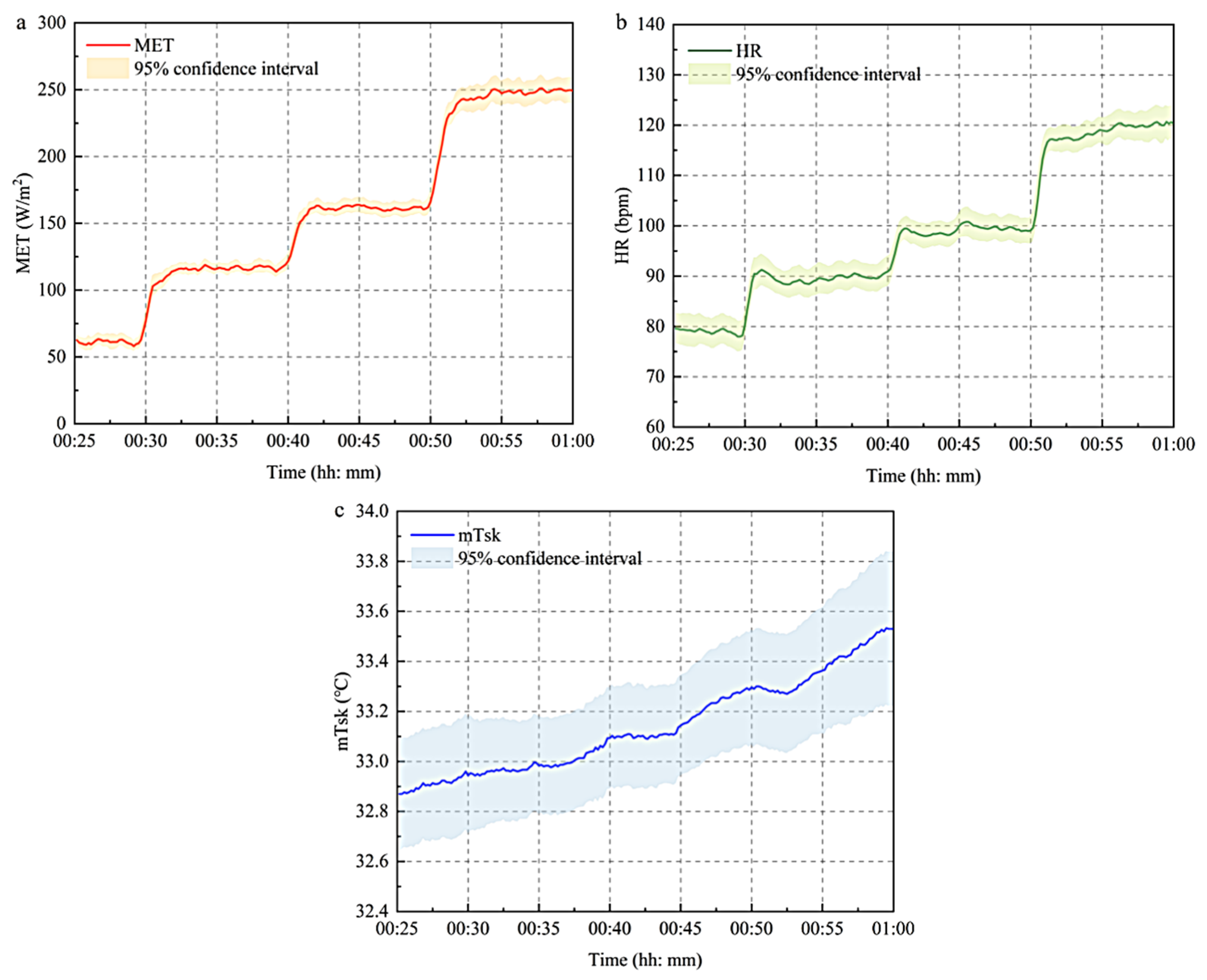

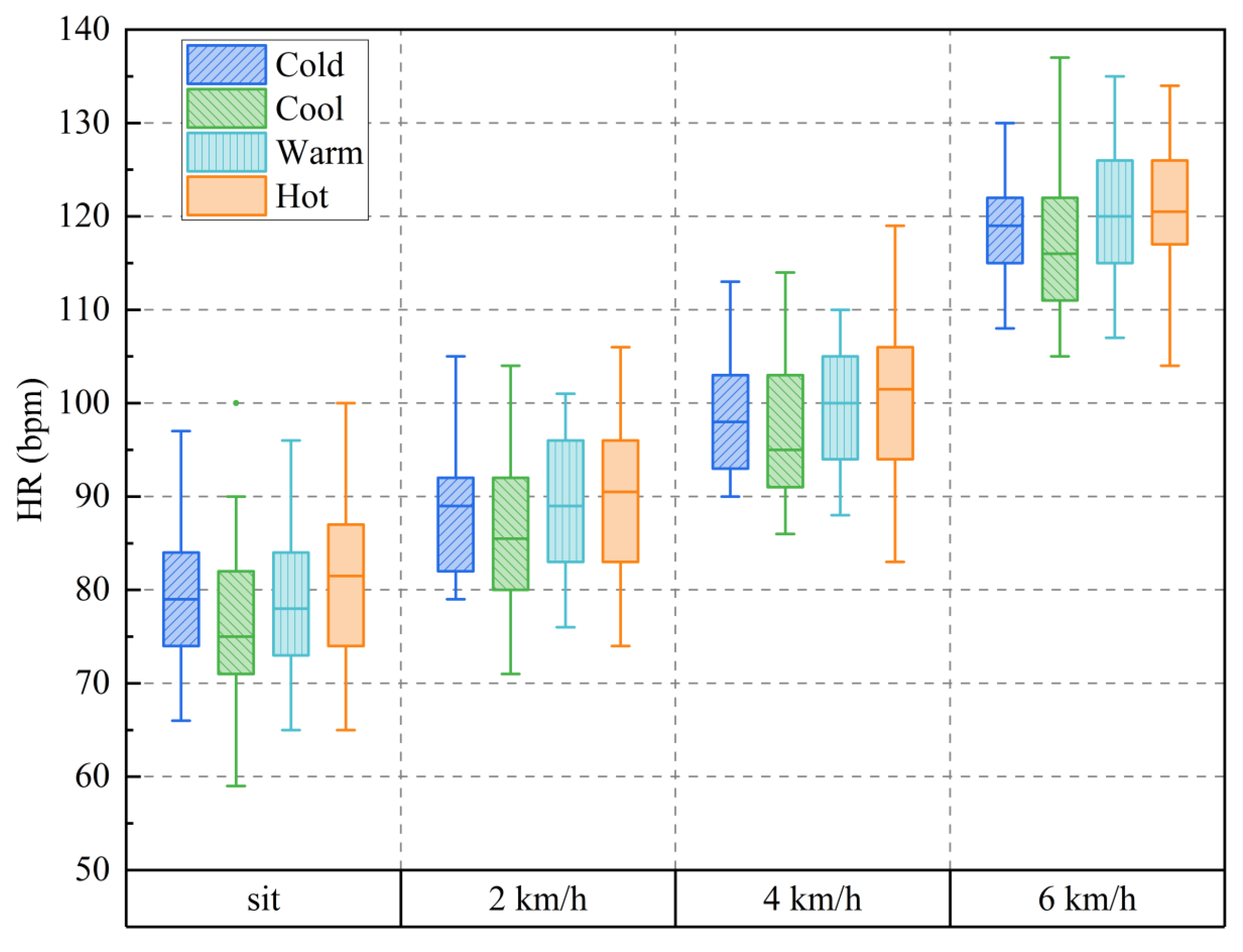

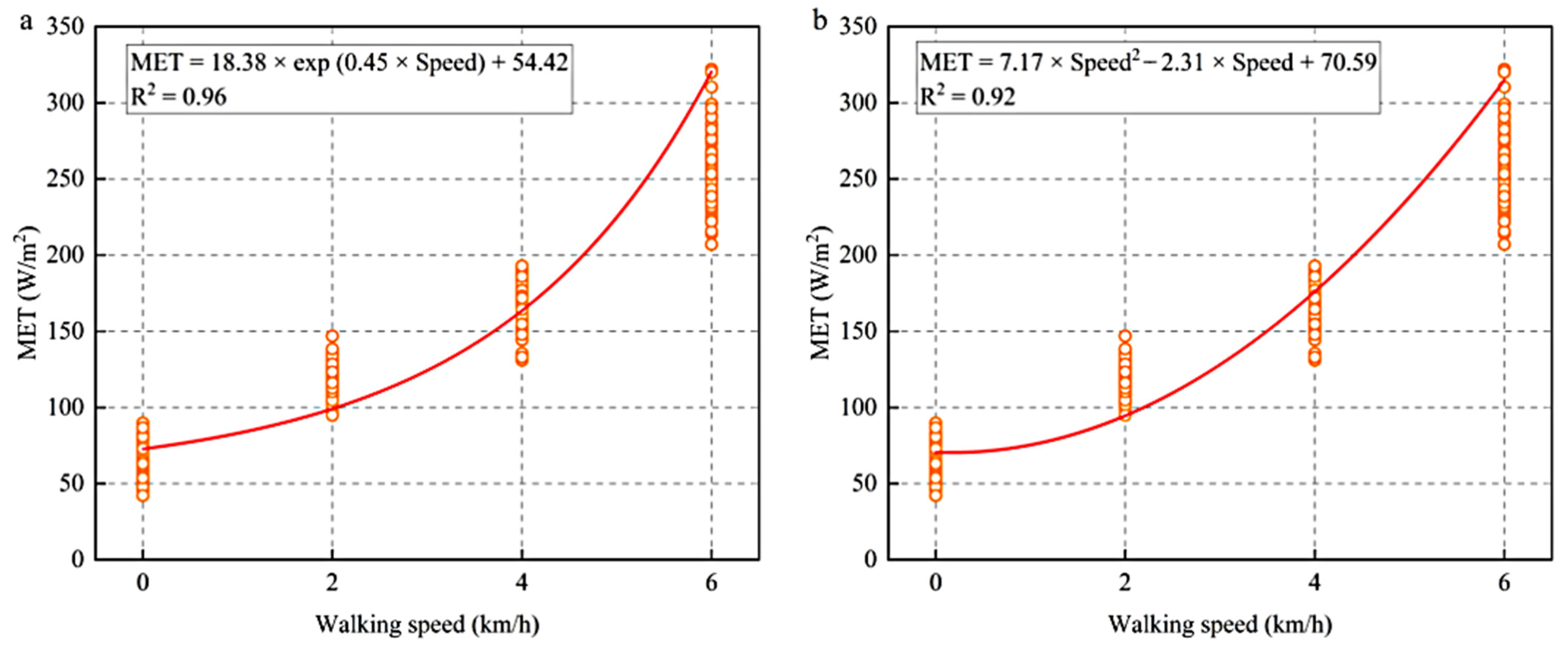


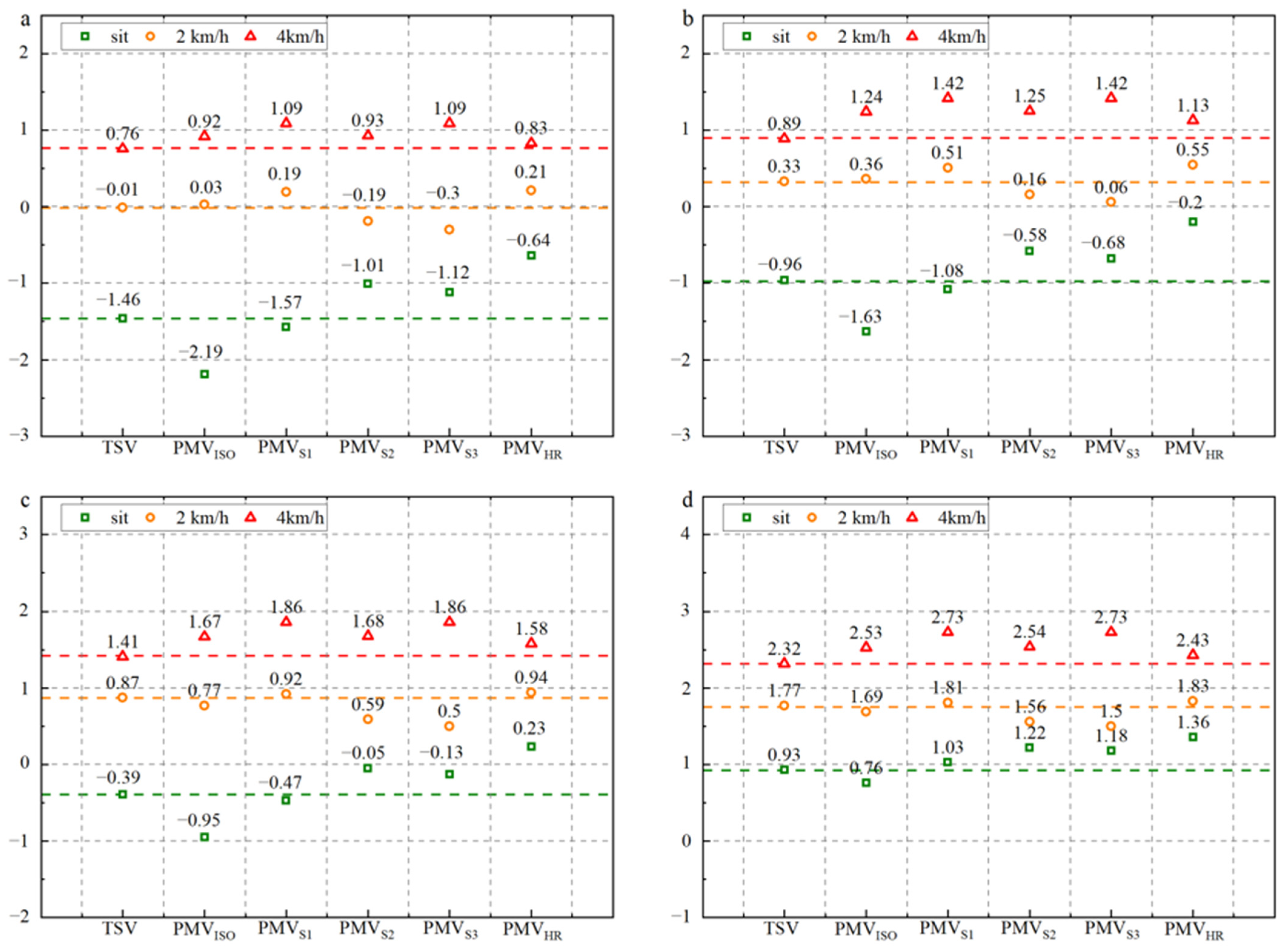

| Sensors | Type | Range | Accuracy |
|---|---|---|---|
| Flow | Digital turbine | ≤20.1 L/s | ±2% |
| O2 | Electrochemistry | 0–100% | <0.1 vol % |
| CO2 | Nondispersive infrared | 0–13% | <0.1 vol % |
| Conditions | 30 | 24 | 18 | 12 |
|---|---|---|---|---|
| Clothing | Men’s briefs | Men’s briefs | Men’s briefs | Men’s briefs |
| Details | T-shirt | Long-sleeved shirt | Long-sleeved shirt | Long-sleeved shirt |
| Walking shorts | Straight trousers | Long johns | Long johns | |
| Short socks | Short socks | Jacket | Down jacket | |
| Sneakers | Sneakers | Straight trousers | Straight trousers | |
| Short socks | Short socks | |||
| Sneakers | Sneakers |
| Parameters | Cold | Cool | Warm | Hot |
|---|---|---|---|---|
| Temperature (°C) | 12.1 ± 0.3 | 17.9 ± 0.4 | 24.0 ± 0.2 | 29.8 ± 0.3 |
| Humidity (%) | 29.1 ± 3.7 | 30.2 ± 3.5 | 29.9 ± 2.9 | 28.2 ± 3.3 |
| Air velocity (m/s) | 0.07 | 0.09 | 0.10 | 0.09 |
| Atmospheric pressure (kPa) | 100.48 | 100.48 | 100.48 | 100.48 |
| Research | Linear Relationships | R2 | Data Sources |
|---|---|---|---|
| This study | MET = 28.38 × Speed + 62.25 | 0.99 | China |
| Anand’s study | MET = 33.30 × Speed + 52.40 | 0.97 | India |
| Zhai’s study | MET = 34.44 × Speed + 54.33 | 0.95 | China |
| ISO 8996 | MET = 28.65 × Speed + 53.78 | 0.99 | Europe |
| ASHRAE Handbook | MET = 24.65 × Speed + 50.60 | 0.94 | America |
| Research | Linear Relationships | R2 | Data Sources |
|---|---|---|---|
| This study in the cool environment | MET = 3.67 × HR − 195.56 | 0.77 | China |
| This study in other environments | MET = 3.80 × HR − 218.90 | 0.76 | China |
| Zhai’s study | MET = 3.27 × HR − 161.30 | 0.68 | China |
| ISO 8996 | MET = 3.80 × HR − 210.00 | — | Europe |
Disclaimer/Publisher’s Note: The statements, opinions and data contained in all publications are solely those of the individual author(s) and contributor(s) and not of MDPI and/or the editor(s). MDPI and/or the editor(s) disclaim responsibility for any injury to people or property resulting from any ideas, methods, instructions or products referred to in the content. |
© 2024 by the authors. Licensee MDPI, Basel, Switzerland. This article is an open access article distributed under the terms and conditions of the Creative Commons Attribution (CC BY) license (https://creativecommons.org/licenses/by/4.0/).
Share and Cite
Jin, R.; Liu, X.; Zhang, H.; Ye, T.; Zheng, W. Metabolic Rate Measuring with Indirect Calorimetry for Thermal Comfort Evaluation. Appl. Sci. 2024, 14, 5363. https://doi.org/10.3390/app14135363
Jin R, Liu X, Zhang H, Ye T, Zheng W. Metabolic Rate Measuring with Indirect Calorimetry for Thermal Comfort Evaluation. Applied Sciences. 2024; 14(13):5363. https://doi.org/10.3390/app14135363
Chicago/Turabian StyleJin, Rui, Xianze Liu, Huan Zhang, Tianzhen Ye, and Wandong Zheng. 2024. "Metabolic Rate Measuring with Indirect Calorimetry for Thermal Comfort Evaluation" Applied Sciences 14, no. 13: 5363. https://doi.org/10.3390/app14135363





